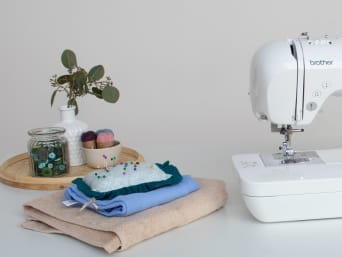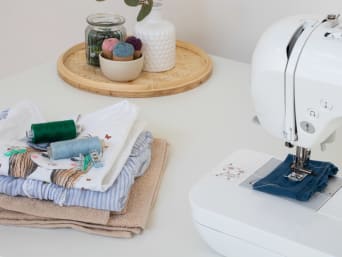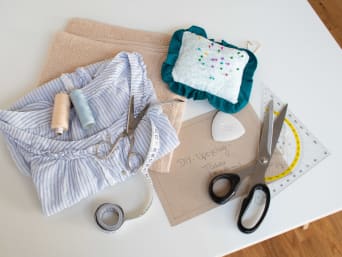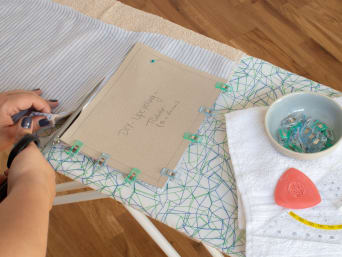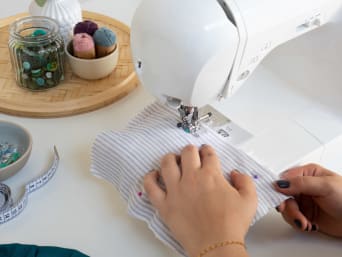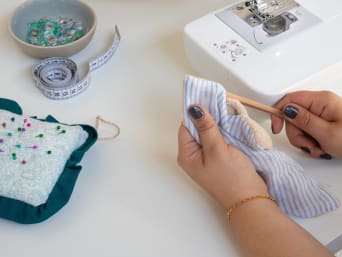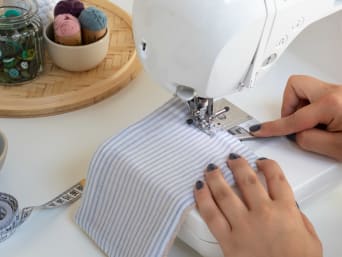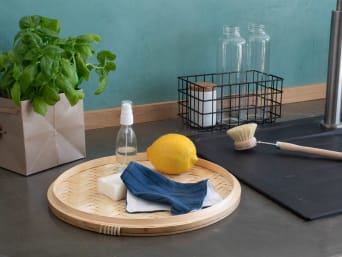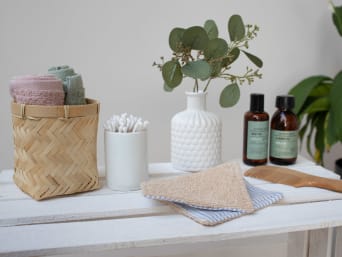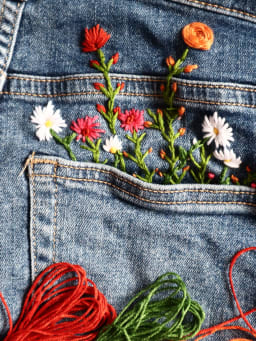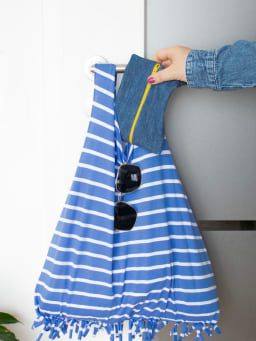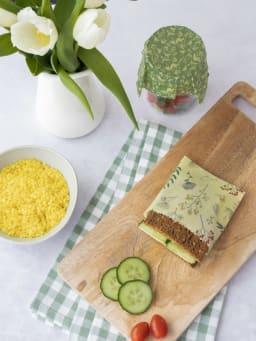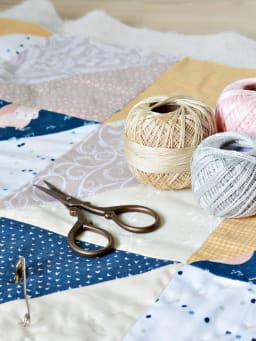How to make reusable kitchen roll & make-up remover pads
Upcycling ideas: turning old clothes into reusable everyday items
Disposable everyday products such as kitchen roll or cotton wool pads cause a lot of household waste. Upcycling your old items of clothing and other household textiles to create environmentally friendly alternatives for many disposable products. Our simple step-by-step sewing guide will help you give your worn clothes and other household textiles a second chance. In addition, we will show you how you can make reusable make-up remover pads, kitchen roll and also reusable baby wipes from your old items of clothing.
The best fabrics for reusable kitchen roll, baby wipes and more
You need to make sure you choose the right fabric depending on what you want to make. It is also important to check how each type of fabric needs to be washed and cared for. In addition, double check if they are heat resistant and absorbent enough for their intended use.
Choosing the right fabric
The properties of the different fabrics also play an important role, therefore, it’s important to choose a suitable fabric for your reusable everyday items.
Keep the following in mind when choosing the right fabric:
First, how well can the fabric absorb moisture. Anything that is going to be used in the kitchen or bathroom needs to be able to absorb moisture.
You should also consider the temperature resistance of the fabric. To remove dirt and bacteria, the fabric should be able to be washed at a high temperature.
Natural fibres are skin-friendly and are a good optionfor baby wipes and make-up remover pads.

It is not uncommon for fabrics to be made of a mixture of fibres. If a fabric only partly contains natural fibres, the added synthetic or animal fibres will change the properties of the fabric. Fabrics made of cotton or viscose are easy to take care of, as they are highly absorbent and can be washed at high temperatures.
Upcycling fabrics
Kitchen roll and make-up remover pads need to be absorbent and heat-resistant to maintain their special properties. However, how they feel on your skin is very important depending on where their intended use.
If you are making reusable bathroom or kitchen wipes to clean your home, they will not need a soft texture. The focus is on the absorbency and temperature resistance of the fabric. Therefore, thicker and coarser fabrics can be suitable for this purpose.
For cosmetic use, for example as make-up remover pads or baby wipes, the texture of the fabric needs to be soft. Smooth fabrics from blouses or t-shirts are recommended for this purpose, as well as soft fabrics from towels and bathrobes or non-woven fabrics made of cotton or viscose.

For people who are new to sewing, fabrics with low elasticity are recommended as they are much easier to work with.
Step-by-step sewing guide for reusable kitchen roll
For beginners, it’s good to start with something easier like kitchen roll, reusable make-up remover pads, or baby wipes, as they are easy to make. If you don’t have a sewing machine, you can sew them by hand. It’s a good idea to have several pieces of kitchen roll, which can easily and quickly be done with a simple household sewing machine.
In addition to a sewing machine, you will also need:
Clothes or household textiles made of natural fibres such as cotton, linen or viscose
Thread in a matching colour
A pair of fabric scissors
Measuring tape or a ruler
Water-soluble pen or a fabric marking pencil
Sheet of paper
Pins
Iron (optional)
Method:
1. When upcycling old clothes, it makes sense to cut the old clothes into individual pieces. You need to simply cut along the seams of the t-shirt or blouse. Starting with a simple rectangular shape is the easiest way to make reusable kitchen towel. A good size to start with is 14 cm x 20 cm as this is about the same size as a hand. Tip: the size and shape can be changed depending on the intended use. For example, you can sew reusable make-up remover pads in a smaller size and round shape.
2. You can always make it bit bigger or a bit smaller if needed. For example, you can cut out your reusable makeup remover pads into a smaller size. Next, use a water-soluble pen to draw a rectangle on one of the pieces of fabric. Alternatively, you can make a template out of cardboard. The advantage of the template is that you can reuse it to make more pieces of kitchen roll at a later date.
3. Before cutting make sure to pay attention to the so-called seam allowance. Otherwise, your cloth will be smaller than planned. Now add another centimetre to each side of your rectangle making it 16 cm x 22 cm.
4. The next step is to cut out the pieces of fabric. Start by laying several layers of fabric on top of each other to save cutting them all individually. Fix the layers of fabric with a few pins to prevent them from slipping. Make sure not to use too many layers, so that your scissors can still cut through them. The number of layers will depend on how thick the fabric is.
5. Next, get two pieces of fabric and join them together. It makes sense to use two different fabrics. If you have patterned fabrics, then combine them with a solid colour. If your fabric is too thin, then add another layer in the middle. The colour and texture are not important as they will not be visible.
6. Now take the two pieces of fabric and place the two right sides together and then sew around the rectangle with about 1 cm gap away from the edge of the fabric. When doing this, you should lock the seam by sewing backwards after the first three or four stitches.
7. Stop sewing about 2 to 3 cm before reaching the seam so that you can leave an opening. To finish the seam, backstitch at the end by sewing a few stitches backwards and then forwards again. If you add a third layer, simply place the additional piece of fabric on top of the other the two pieces on the right.

A piece of fabric always has a left and a right side. The right side is considered to be the more better-looking side as it always faces outwards on clothes.
8. Next, turn the two joined layers of fabric inside out by bringing the inside out through the opening. Make sure you smooth out the edges and the corners to keep a nice rectangular shape. By using an iron, you can make this job a lot easier. For a three-layered cloth, make sure the two original layers are on the outside and the third is on the inside.
9. Lastly, sew a wide decorative stitch around the edge so that you can close both the opening and to permanently fix the shape of the rectangle. Place the edge of your sewing machine presser foot against the outer edge of your sewing product. Finally, your reusable wipe is ready to be used as a reusable kitchen roll or as reusable make-up remover pad, depending on the material.
How to make reusable kitchen wipes
With enough pieces of reusable kitchen roll made of absorbent, durable and heat-resistant cotton, you can eliminate all paper towels from your kitchen and reduce your household waste.
Old t-shirts, jumpers or even flannel shirts are all good options as the texture isn’t important if it is going to be used as a reusable kitchen roll. In addition, using two layers of fabric will be enough.
It is important to wash reusable kitchen towels at a high temperature, as they can quickly become dirty and full of bacteria. Washing at 60°C is usually sufficient to remove dirt and to kill any bacteria. However, if you don’t want to take any risks, you can wash them at 90°C.
Tip: In the following article we will show you how to make your own environmentally friendly laundry detergent: Homemade washing powder & laundry detergent
How to make reusable make-up remover pads
These reusable make-up remover pads made of upcycled fabrics can replace face wipes and cotton wool pads. It’s a good idea to use two different types of fabric. A good combination is a soft terry towelling from old towels, washcloths and a smooth fabric from a blouse or a bathrobe.
Terry towelling is usually thick enough to make a cloth from just two layers. You should add a third layer if you are going to use thinner materials.
Some cosmetic products, such as mascara and eyeliner can cause discolouration or they can even cause stains. That’s why it is a good idea to use colourful fabrics for your reusable make-up remover pads, as a slight discolouration will not be as visible. Your reusable make-up remover pads should be washed at 60°C or 90°C, depending on how dirty they are. However, washing at 60°C is more environmentally friendly.
How to make reusable baby wipes
Baby wipes are made the exact same way as reusable make-up remover pads. Follow the exact same instructions and use the same fabrics and measurements.
Once your baby wipes are finished, you will need to make the solution so that they are moist. You should soak your wipes and then gently wring them out so that they are still damp.
What you will need:
500 ml of distilled or boiled water
One teaspoon of coconut oil
One teaspoon of sunflower oil
Pan
Spoon
Method
Start off, by heating the water in a pan to 30°C or 40°C
Now, add the coconut oil and stir until it is completely dissolved. Repeat this step with a tablespoon of sunflower oil until completely dissolved.
Now dampen your reusable baby wipes with the solution
Finally, don’t forget to store your baby wipes in a resealable airtight container to preserve the moisture.
Conclusion: giving your old clothes a new lease of life
You can easily make your own kitchen towel, kitchen wipes, make-up remover pads and baby wipes from old items of clothing. These upcycling ideas will give your old clothes a new lease of life. By avoiding disposable products, you can also reduce your household waste, protect the environment and save money.
______________________________________________
References and further information
https://icansewthis.com/reusable-cotton-rounds/
(Last accessed on 19.06.2024)
https://pebblemag.com/upcycling-clothes/
(Last accessed on 19.06.2024)
https://www.realsimple.com/ways-to-reuse-old-clothes-8637963
(Last accessed on 19.06.2024)
https://www.verywellfamily.com/how-to-make-reusable-baby-wipes-284469
(Last accessed on 19.06.2024)
The image sources in this text are in chronological order
All images in this text are from C&A
